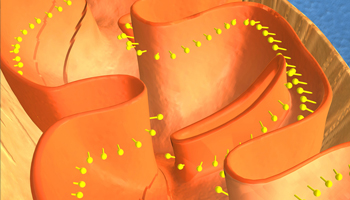HOW CAN WE HELP YOU? Call 1-800-TRY-CHOP
In This Section
Mitochondrial Gene Defects Associated With Autism Traced Back to Ancient Times
 Differences in mitochondrial function are a major factor in understanding the origins of autism spectrum disorders (ASD), according to a new study led by Douglas Wallace, PhD, director of the Center for Mitochondrial and Epigenomic Medicine at Children’s Hospital of Philadelphia, that points way back to genetic vulnerabilities accumulated during ancient human migrations.
Differences in mitochondrial function are a major factor in understanding the origins of autism spectrum disorders (ASD), according to a new study led by Douglas Wallace, PhD, director of the Center for Mitochondrial and Epigenomic Medicine at Children’s Hospital of Philadelphia, that points way back to genetic vulnerabilities accumulated during ancient human migrations.
Today, the prevalence of ASD is estimated to be one in 68 among 8-year-old children. They are usually diagnosed around age 4 in the U.S., with a wide variation in symptoms that can range from mild to severe. Difficulties in social interaction and communication, repetitive behaviors, and restricted interests are some of the impairments that characterize children with ASD.
Previous research suggests that children with ASD have a spectrum of mitochondrial alterations. The mitochondria are small organelles that generate most of our cellular energy through a process called oxidative phosphorylation (OXPHOS). The brain’s interneurons are greedy for energy, which makes it particularly susceptible to even partial defects of mitochondrial function. Declines in mitochondrial energy metabolism can disturb the delicate balance between inhibition and excitation in brain activity and result in the hyperexcitable states associated with autism and other neuropsychiatric disorders, Dr. Wallace explained in a recent editorial appearing in JAMA Psychiatry.
Disruptions in OXPHOS and bioenergetics can stem from mutations that occur in mitochondria’s own DNA (mtDNA), which are distinct from the more familiar nuclear DNA (nDNA) inside the cell nucleus. Almost 40 years ago, Dr. Wallace, who also is on the faculty of the Perelman School of Medicine at the University of Pennsylvania, discovered that human mtDNA is inherited only through the mother. He used this knowledge to reconstruct the ancient migrations of women by comparing variation in mtDNA among populations — called haplogroups — throughout the world.

The current study analyzed these mtDNA lineages among 1,624 patients with autism and 2,417 healthy parents and siblings, representing 933 families in the Autism Genetic Resource Exchange (AGRE). Using data from genome-wide association studies on this AGRE cohort previously performed by the Center for Applied Genomics at CHOP, they determined patterns of functional mtDNA variants associated with ASD risk that emerged over human history.
The study team found that individuals with European haplogroups designated I, J, K, O-X, T and U (representing 55 percent of the total European population) had significantly higher risks of ASD compared to the most common European haplogroup, HHV. Asian and Native American haplogroups A and M also were at increased risk of ASD.
These findings support the idea that an individual already predisposed to ASD based on their mitochondrial haplogroup may develop the disease when additional genetic variants or environmental insults occur that lower mitochondrial function, impair OXPHOS, and alter brain activity.
“The unique genetics of the mitochondrion can now account for many of the puzzling features of ASD genetics,” Dr. Wallace and colleagues wrote about the current study that also appears in JAMA Psychiatry.
For example, the tendency for ASD to occur more frequently in males than females is consistent with a well-known mtDNA disease, Leber hereditary optic neuropathy, which also preferentially affects males. The lower risk of blindness in females may arise from estrogen effects in mitochondria that increase beneficial antioxidant activity.
Dr. Wallace and colleagues will continue their research with the support of a grant from the National Institute of Mental Health. They are studying mice harboring mtDNA variants causing partial OXPHOS dysfunction to see if it contributes to an imbalance in excitation-inhibition interneurons resulting in behavioral and cognitive manifestations similar to ASD.
The study’s co-first authors are Dimitra Chalkia, PhD, and Larry Singh, PhD, of the Center for Mitochondrial and Epigenomic Medicine.
Read more about the provocative findings in JAMA Psychiatry.